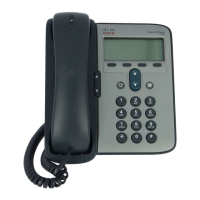2-5
Cisco Unified IP Phone 7906G and 7911G Administration Guide for Cisco Unified CallManager 5.1
OL-11515-01
Chapter 2 Preparing to Install the Cisco Unified IP Phone on Your Network
Providing Power to the Cisco Unified IP Phone 7906G and 7911G
Power Guidelines
Table 2-1 provides guidelines that apply to external power and to PoE power for
phones the Cisco Unified IP Phone 7906G and 7911G.
Obtaining Additional Information about Power
For related information about power, refer to the documents shown in Table 2-2.
These documents provide information about these topics:
• Cisco switches that work with the Cisco Unified IP Phone 7906G and 7911G
• The Cisco IOS releases that support bidirectional power negotiation
• Other requirements and restrictions regarding power
Ta b l e 2-1 Guidelines for Powering the Cisco Unified IP Phone 7906G and 7911G
Power Type Guidelines
External power—
Provided through a Cisco
external power supply.
The CP-PWR-CUBE-3 external power supply may be used with the
Cisco
Unified IP Phone 7906G and 7911G.
External power—
Provided through the
Cisco Unified IP Phone
Power Injector.
The Cisco Unified IP Phone Power Injector may be used with any
Cisco
Unified IP Phone. Functioning as a midspan device, the injector
delivers inline power to the attached phone. The Cisco Unified IP Phone
Power Injector is connected between a switch port and the IP Phone, and
supports a maximum cable length of 100m between the unpowered switch
and the phone.
PoE power—Provided by
a switch through the
Ethernet cable attached to
the phone.
• The Cisco Unified IP Phone 7906G and 7911G supports both Cisco
inline power and IEEE 802.3af Power over Ethernet.
• To ensure uninterruptible operation of the phone, make sure that the
switch has a backup power supply.
• Make sure that the CatOS or IOS version running on your switch
supports your intended phone deployment. Refer to the documentation
for your switch for operating system version information.

